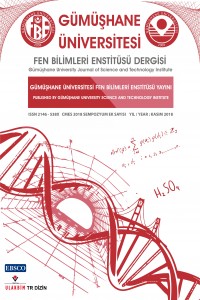Türk Ortaokul Öğrencileri için Makine Öğrenmesi Yöntemleri Kullanılarak Fiziksel Uygunluk Tahmin Modelleri Geliştirme
Abstract
Fiziksel
uygunluk, belirli testlerle ölçülebilen sağlık veya beceri ile ilgili bir dizi
özelliktir. Fiziksel uygunluğu korumak sağlık ve esenlik için çok önemlidir.
Ancak, fiziksel uygunluğun ölçülmesi profesyonel ekipman, deneyimli personel ve
çok zaman gerektirdiğinden,
araştırmacıların fiziksel uygunluğu belirlemek için farklı yollara ihtiyaçları
vardır. Bu çalışmanın amacı, Destek Vektör Makineleri (SVM), Radyal Tabanlı
Fonksiyon Sinir Ağı (RBFNN) ve Ağaç Artımı (TB) gibi makine öğrenme
yöntemlerini kullanarak Türk ortaokul öğrencilerinin fiziksel uygunluğunu
tahmin etmek için yeni tahmin modelleri geliştirmektir. Veri seti 30m hız, 20m
aşama koşusu, denge ve çeviklik testlerinin sonuçlarından oluşan veriyi içermektedir.
Tahmin modellerini geliştirmek için kullanılan tahmin değişkenleri cinsiyet, yaş, boy, kilo, vücut yağı, 30
saniyedeki mekik ve şınav sayılarından oluşmaktadır. Tahmin modellerinin
performansı Ortalama Karesel Hata (RMSE) kullanılarak hesaplanmıştır.
Sonuçlar, SVM tabanlı tahmin modellerinin, RBFNN ve TB'ye dayanan diğer
modelleri geride bıraktığını göstermektedir. Ayrıca, fiziksel uygunluk tahmini
için vücut yağı, mekik ve şınav gibi tahmin değişkenlerinin birlikte
kullanılması durumunda sonuçlar üzerinde önemli bir rol oynadığını gösterilmiştir.
Keywords
References
- Abut, F., Akay, M.F., Sow, B. and George, J. 2015. Support Vector Machines for Prediction of Endurance Times Involving Isometric Side Bridge Exercise Test, Third International Symposium on Engineering, Artificial Intelligence & Applications (ISEAIA2015), North Cyprus, pp. 7-9.
- Ahmed, M.U., Loutfi, A., 2013. Pyhsical Activity Identification using Supervised Machine Learning and based on Pulse Rate, International Journal of Computer Science and Applications, Publication 4(7).
- Chuang, C.C., Lee, Z.C., 2011. Hybrid robust support vector machines for regression without liers, Applied Soft Computing.
- Dijkhuis,T.B., Blaauw, F., Ittersum,M. W., Aiello, M. 2018. Personalized Physical Activity Coaching : A Machine Learning Approach, in Sensors, 18(2), p.623.
- Fergus, P., Hussain,A., Hearty, J., Fairclough,S., Boddy, L., Machintoch, K.A., Stratton,G., Ridgers, N.D. and Radi, N. 2015. A Machine Learning Approach to Measure and Monitor Physical Activity in Children to Help Fight Overweight and Obesity, Intelligent Computing Theories and Methodologies: 11th International Conference, ICIC 2015, Fuzhou, China, pp. 676-688.
- Hannan, S.A., Manza, R.R., Ramteke, R.J. 2010. Generalized Regression Neural Network and Radial Basis Function for Heart Disease Diagnosis, International Journal of Computer Applications, Volume 13, Issue 2, ISBN: 10.5120/1325-1799.
- Hoffman, J., 2006. Norms for Fitness, Performance and Health, Human Kinetics Publishers, ISBN-13: 9780736054836, 97–104.
- Reichherzer, T., Timm, M., Earley, N., Reyes, N., 2017. Using Machine Learning Techniques to Track Individuals & Their Fitness Activities, In A. Bossard, G. Lee, & L. Miller (Eds.), Proceedings of 32nd International Conference on Computers and Their Applications, Honolulu, Hawaii, USA, pp. 119–124.
- Wang, L., 2005. Support Vector Machines: Theory and Applications, Springer Science & Business Media, Volume 177, 1st Edition: ISBN: 978-3-540-32384-6.
Development of Physical Fitness Prediction Models for Turkish Secondary School Students Using Machine Learning Methods
Abstract
Physical
fitness is a set of attributes that are either health or skill-related which
can be measured with specific tests. Maintaining physical fitness is essential
for health and wellbeing. However, since measurement of physical fitness
requires improved professional equipment, experienced staff and lots of time,
researchers need different ways to determine physical fitness. The aim of this
study is to develop new prediction models for predicting the physical fitness
of Turkish secondary school students by using machine learning methods
including Support Vector Machines (SVM), Radial Basis Function Neural Network
(RBFNN) and Tree Boost (TB). The dataset comprises data of various number of
subjects according to the target variables such as the test scores of the 30m
speed, 20m stage run, balance and agility. The predictor variables used to
develop the prediction models are gender, age, height, weight, body fat, number
of curl-up and push-ups in 30 seconds. Root Mean Square Error (RMSE) has been
utilized to assess the performance of the prediction models. Based on the
results we can conclude that SVM based prediction models outperform other
models based on RBFNN and TB. Also, the predictor variables body fat, push-up
and curl-up play a significant role when used all together for physical fitness
prediction.
Keywords
References
- Abut, F., Akay, M.F., Sow, B. and George, J. 2015. Support Vector Machines for Prediction of Endurance Times Involving Isometric Side Bridge Exercise Test, Third International Symposium on Engineering, Artificial Intelligence & Applications (ISEAIA2015), North Cyprus, pp. 7-9.
- Ahmed, M.U., Loutfi, A., 2013. Pyhsical Activity Identification using Supervised Machine Learning and based on Pulse Rate, International Journal of Computer Science and Applications, Publication 4(7).
- Chuang, C.C., Lee, Z.C., 2011. Hybrid robust support vector machines for regression without liers, Applied Soft Computing.
- Dijkhuis,T.B., Blaauw, F., Ittersum,M. W., Aiello, M. 2018. Personalized Physical Activity Coaching : A Machine Learning Approach, in Sensors, 18(2), p.623.
- Fergus, P., Hussain,A., Hearty, J., Fairclough,S., Boddy, L., Machintoch, K.A., Stratton,G., Ridgers, N.D. and Radi, N. 2015. A Machine Learning Approach to Measure and Monitor Physical Activity in Children to Help Fight Overweight and Obesity, Intelligent Computing Theories and Methodologies: 11th International Conference, ICIC 2015, Fuzhou, China, pp. 676-688.
- Hannan, S.A., Manza, R.R., Ramteke, R.J. 2010. Generalized Regression Neural Network and Radial Basis Function for Heart Disease Diagnosis, International Journal of Computer Applications, Volume 13, Issue 2, ISBN: 10.5120/1325-1799.
- Hoffman, J., 2006. Norms for Fitness, Performance and Health, Human Kinetics Publishers, ISBN-13: 9780736054836, 97–104.
- Reichherzer, T., Timm, M., Earley, N., Reyes, N., 2017. Using Machine Learning Techniques to Track Individuals & Their Fitness Activities, In A. Bossard, G. Lee, & L. Miller (Eds.), Proceedings of 32nd International Conference on Computers and Their Applications, Honolulu, Hawaii, USA, pp. 119–124.
- Wang, L., 2005. Support Vector Machines: Theory and Applications, Springer Science & Business Media, Volume 177, 1st Edition: ISBN: 978-3-540-32384-6.
Details
| Primary Language | English |
|---|---|
| Subjects | Engineering |
| Journal Section | Articles |
| Authors | |
| Publication Date | November 30, 2018 |
| Submission Date | June 30, 2018 |
| Acceptance Date | November 30, 2018 |
| Published in Issue | Year 2018 CMES 2018 |

